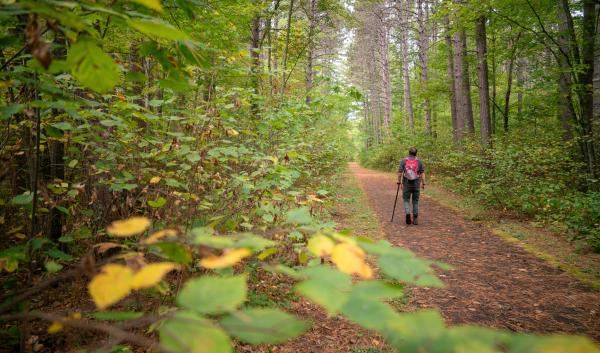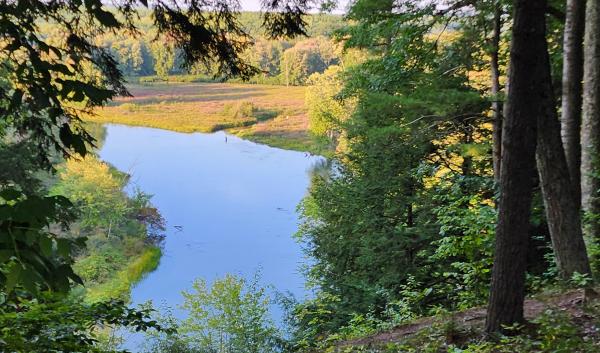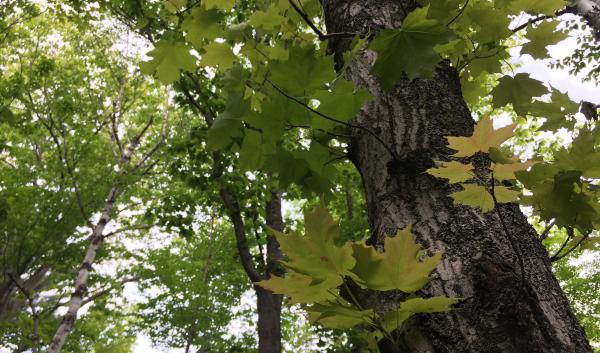This assessment synthesizes the best available scientific information on climate change and forest ecosystems. Its primary goal is to inform forest managers in the Northeast region, in addition to other people who study, recreate, and live in these forests.

Forests and ecosystems in the Northeast region will be affected directly and indirectly by a changing climate over the next 100 years. Understanding potential impacts is an important first step to sustaining healthy forests in the face of changing conditions.
The assessment synthesizes information on the contemporary landscape, collects information on past climate trends, and describes a range of projected future climates. This information, in turn, is used as the basis of multiple forest impact models, which provide a range of potential tree responses to climate scenarios.
The results of these models were vetted by two multidisciplinary panels of scientists and land managers familiar with the forests of this region to assess ecosystem vulnerability through a formal consensus-based expert elicitation process that evaluated 8 representative forest ecosystems in the Northeast region (northern New York, Vermont, Massachusetts, Connecticut, Rhode Island, New Hampshire, and Maine) under a range of future climates.
Major Findings
- Observed trends in climate over the historical record from 1901 through 2011 show that the mean annual temperature has increased across the region by 2.4 °F, with even greater warming during winter.
- Precipitation patterns also changed during this time, with a slight trend toward greater annual precipitation and a substantial increase in extreme precipitation events.
- Projected climate trends, using downscaled global climate model data, indicate a potential increase in mean annual temperature of 3 to 8 °F for the assessment area by 2100.
- Projections for precipitation indicate an increase in fall and winter precipitation, and spring and summer precipitation projections vary by scenario.
- Model projections suggest that many northern and boreal species, including balsam fir, red spruce, and black spruce, may fare worse under future conditions. Still, other species may benefit from projected changes in climate.
Overview of key findings from the New England forest ecosystem vulnerability assessment
Details Of The Vulnerability Assessment
The information below is a summary of each chapter available in the vulnerability assessment. For more information and in-depth discussion please refer to the full report.
This chapter describes the forests and related ecosystems of New England and northern New York and summarizes current threats and management trends. The information lays the foundation for understanding how shifts in climate may contribute to changes in forest ecosystems, and how climate may interact with other stressors on the landscape.
- Of the nearly 53 million acres of land in the assessment area of New England and northern New York, about 40 million acres are forest. Maple/beech/birch and spruce/fir are the most abundant forest-type groups across the area. Private individuals and organizations own about 80 percent of the forest land.
- Historical land use and past management practices have tended to favor younger forests across the landscape and have often reduced species diversity and structural complexity.
- Current major stressors and threats to forest ecosystems in the assessment area include:
- Fragmentation and land-use change
- Fire regime shifts
- Invasion by nonnative species
- Forest diseases and insect pests
- Overbrowsing
- Extreme weather events
- The forest products industry is a major contributor to the regional economy. Ninety percent of the forest land in the assessment area is classified as timberland, meaning that it is considered suitable for wood production because forest harvesting is not prohibited. Across the assessment area, the amount of wood harvested each year is less than the amount of forest growth.
Many of the climatic changes that have been observed across the world over the past century are also evident in the assessment area. This chapter summarizes our current understanding of observed changes and current climate trends in the assessment area and across the Northeast region, with a focus on the last 50 to 100 years.
- Across the assessment area, the mean annual temperature increased by 2.4 °F (1.3 °C) between 1901 and 2011. Mean, minimum and maximum temperatures increased across all seasons over the past century, with winter temperatures warming the most rapidly.
- Precipitation patterns have changed across the region, with a trend toward greater annual precipitation in the assessment area. The number of extreme precipitation events has increased. Snowfall has generally decreased across the assessment area.
- Climate change has caused substantial sea-level rise, with an increase of 12 inches across the northeastern United States and an even greater increase along the New England coastline observed since 1900.
- Climate change has also been indicated by trends showing reductions in lake ice, increased growing season length, and shifts in plant and animal phenology.
This chapter describes climate projections for the assessment area over the 21st century. Temperature and precipitation projections are derived from downscaled simulations of climate models. Published scientific literature provides the basis for describing possible trends in a range of climate-driven processes, such as extreme weather events and snowfall.
- Temperatures are expected to continue to increase over the next century. A range of climate scenarios project warming in all seasons.
- Precipitation is projected to increase in winter and spring across a range of climate scenarios. Projections of summer and fall precipitation are more variable. Intense precipitation events are expected to continue to become more frequent.
- Winters will continue to become shorter and milder. Snowfall is projected to continue to decline across the assessment area, with more winter precipitation falling as rain. Soils are projected to be frozen for shorter periods during winter.
This chapter, drawing on information from a coordinated series of model simulations and published research, summarizes the potential impacts of climate change on forests in the assessment area.
- Boreal species such as balsam fir, red spruce, and black spruce are projected to have reductions in suitable habitat and biomass over the next century.
- Species with ranges that extend to the south such as red maple, northern red oak, black cherry, and American basswood may have increases in suitable habitat and biomass.
- Many currently common species are projected to decline under a hotter, drier future climate scenario, particularly in the southern portion of the assessment area.
- Forest productivity will be influenced by a combination of factors such as carbon dioxide fertilization, water and nutrient availability, succession, disturbance, and species migration.
- The model projections used in this assessment do not account for many other factors that may change under a changing climate, such as forest disturbance. Scientific literature was used to provide additional information on these factors, including:
- Altered precipitation and hydrology
- Drought stress
- Wildfire frequency and severity
- Altered nutrient cycling
- Changes in invasive species, insect pests, and forest diseases
- Interactions among these factors.
Forest ecosystems across New England and northern New York will face direct and indirect impacts from a changing climate over the 21st century. We assessed the vulnerability of major forest systems in the assessment area to climate change through the year 2100, focusing on shifts in dominant species, system drivers, and stressors. The adaptive capacity of forest systems was also examined as a key component of overall vulnerability. Synthesis statements are provided to capture general trends, and detailed vulnerability determinations are provided for eight major forest systems.
Potential Impacts on Drivers and Stressors
- Temperatures will increase (robust evidence, high agreement). All global climate models agree that temperatures will increase with continued increases in atmospheric greenhouse gas concentrations.
- Growing seasons will lengthen (robust evidence, high agreement). There is strong agreement that projected temperature increases will lead to longer growing seasons in the assessment area.
- Winter processes will change (robust evidence, high agreement). There is strong evidence that temperatures will increase more in winter than in other seasons across the assessment area, leading to changes in snowfall, soil frost, and other winter processes.
- Sea levels will continue to rise (robust evidence, high agreement). There is substantial evidence that ongoing sea-level rise will continue to affect low-lying coastal areas and increase potential impacts from flooding, saltwater intrusion, and storm surge.
- The amount and timing of precipitation will change (robust evidence, high agreement). There is strong agreement that precipitation patterns will change across the assessment area. Total precipitation is generally expected to increase during winter and spring, but summer and fall projections are more uncertain.
- Intense precipitation events will continue to become more frequent (robust evidence, high agreement). Climate models generally project that the number of heavy precipitation events will continue to increase in the assessment area. If they do increase, damage from flooding and soil erosion may also become more severe.
- Soil moisture patterns will change in response to temperature and precipitation (medium evidence, high agreement). Warmer temperatures and altered precipitation will interact to change soil moisture patterns throughout the year, but there is uncertainty about the direction and magnitude of the changes.
- Forest vegetation may face an increased risk of moisture deficit and drought during the growing season (medium evidence, medium agreement). Studies show that climate change will affect soil moisture, but there is some disagreement among climate and impact models on how soil moisture and drought will change during the growing season.
- Certain insect pests and pathogens will increase in occurrence or become more damaging (medium evidence, high agreement). Evidence indicates that increases in temperature will lead to increased threats from insect pests and pathogens, but research to date has examined relatively few species.
- Many invasive plants will increase in extent or abundance (medium evidence, high agreement). Evidence indicates that increases in temperature, longer growing seasons, and more frequent disturbances will lead to increases in many invasive plant species.
Potential Impacts on Forests
- Many northern and boreal tree species will face increasing stress from climate change (medium evidence, high agreement). Ecosystem models agree that northern and boreal tree species will have reduced suitable habitat and biomass across the assessment area, and that they may be less able to take advantage of longer growing seasons and warmer temperatures than warm adapted, temperate forest species.
- Habitat will become more suitable for southern species (medium evidence, high agreement). Ecosystem models agree that longer growing seasons and warmer temperatures will increase suitable habitat and biomass for many temperate species across the assessment area.
- Forest composition will change across the landscape (medium evidence, high agreement). Although few models have specifically examined how forest communities may change, model results from individual species and ecological principles suggest that recognized forest community assemblages will change.
- Shifts in forest composition will take at least several decades to occur in the absence of major disturbance (medium evidence, medium agreement). Although some models indicate major changes in habitat suitability, results from spatially dynamic forest landscape models indicate that a major shift in forest composition across the landscape may take 100 years or more in the absence of major disturbances.
- Conditions affecting tree regeneration and recruitment will change (medium evidence, high agreement). Seedlings are more vulnerable than mature trees to changes in temperature, moisture, and other seedbed and early growth requirements.
- Forest productivity will increase during the next several decades in the absence of significant stressors (medium evidence, medium agreement). Some studies have examined the impact of climate change on forest productivity within the assessment area, but they disagree on how multiple factors may interact to influence productivity. The diversity of forest conditions across the assessment area suggests that changes will be spatially variable.
Adaptive Capacity Factors
- Low-diversity systems are at greater risk (medium evidence, high agreement). Studies have consistently shown that high-diversity systems are more resilient to disturbance. Low-diversity systems are expected to be more vulnerable to climate change.
- Tree species in isolated or fragmented landscapes will have a reduced ability to migrate to new areas in response to climate change (limited evidence, high agreement). The dispersal ability of individual tree species is reduced in fragmented landscapes, but the degree of landscape fragmentation in the future is an area of uncertainty.
- Species or systems that are limited to particular environments will have less opportunity to migrate in response to climate change (limited evidence, high agreement). Our current ecological understanding indicates that migration to new areas will be particularly difficult for tree species and forest communities with narrow habitat requirements.
- Ecosystems that have greater tolerance to disturbance have less risk of declining on the landscape (medium evidence, high agreement). Basic ecological theory and other evidence support the idea that systems adapted to more frequent disturbance will be at lower risk.
This chapter summarizes the implications of potential climate change to forest management and planning in the assessment area. This chapter does not make recommendations as to how management should be adjusted to cope with these impacts, because impacts and responses will differ by ecosystem, ownership, and management objective.
- Plants, animals, and people that depend on forests may face additional challenges as the climate shifts.
- Greater financial investments may be required to manage forests and infrastructure and to prepare for severe weather events.
- Management activities such as wildfire suppression or recreational activities such as snowmobiling and skiing may need to be altered as temperatures and precipitation patterns change.
- Climate change may present opportunities for the forest products industry, recreation, and other sectors if changing conditions are anticipated.
How To Cite This Report
Janowiak, Maria K.; D’Amato, Anthony W.; Swanston, Christopher W.; Iverson, Louis; Thompson, Frank R., III; Dijak, William D.; Matthews, Stephen; Peters, Matthew P.; Prasad, Anantha; Fraser, Jacob S.; Brandt, Leslie A.; Butler-Leopold, Patricia; Handler, Stephen D.; Shannon, P. Danielle; Burbank, Diane; Campbell, John; Cogbill, Charles; Duveneck, Matthew J.; Emery, Marla R.; Fisichelli, Nicholas; Foster, Jane; Hushaw, Jennifer; Kenefic, Laura; Mahaffey, Amanda; Morelli, Toni Lyn; Reo, Nicholas J.; Schaberg, Paul G.; Simmons, K. Rogers; Weiskittel, Aaron; Wilmot, Sandy; Hollinger, David; Lane, Erin; Rustad, Lindsey; Templer, Pamela H. 2018. New England and northern New York forest ecosystem vulnerability assessment and synthesis: a report from the New England Climate Change Response Framework project. Gen. Tech. Rep. NRS-173. Newtown Square, PA: U.S. Department of Agriculture, Forest Service, Northern Research Station. 234 p. https://doi.org/10.2737/nrs-gtr-173




